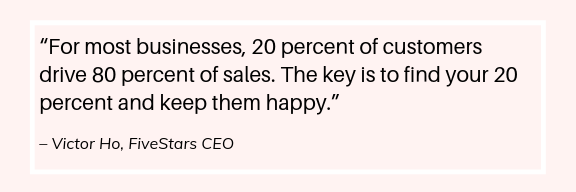
For me, the ultimate sign of growth is a Camilla that blooms. It’s in my blood. My grandfather owned and operated a family nursery most of his adult life. But, unfortunately, growing and maintaining a business is not as simple as when he worked in the nursery. So, how do you grow your business today?
You’re looking for that one thing that will skyrocket your business to the next level. Aren’t we all? Some companies promise quick and easy ways to grow your business but beware. This can cause more harm than good. Plus, if it were that easy, we’d all be doing it.
Growing a successful business takes a lot of hard work. And it doesn’t happen overnight. The good news is when you love what you do, it doesn’t feel like work. But we all know, time is limited.
So, I created this list of nine ways to grow your business. You can pick and choose the right strategy for your business now and implement others later. Ready to get started? Great – let’s do it!
1. Clarify Your Message
Creating a clear message is by far the most overlooked strategy. If you do this one thing, you’ll be a step ahead of the competition.
Clever or cute marketing often misses the point, and people don’t understand what you offer or sell. A vague message such as “Experience a new Destination” is a good example. This could be a travel company, a hotel company, or a vacation rental company. It could be anything. That’s the problem.
Online, people have limited attention spans. You have to get your message across in 5 seconds. If people don’t stay on your homepage for long, it could mean your message isn’t clear. You work hard getting traffic to your site, much less to have them leave once there.
Okay, I see you’re now frantically reading your website and materials. And, I’m sure the message is crystal clear to you. Often, you’re too close to what you do. Ask five people to read your website, sales page, or flyer and repeat what you offer. Did they get the message? If not, you have some work to do.
Clarity wins, and a message that’s easy to remember is repeatable. The right words are powerful. So get crystal clear with your message – everywhere.
2. Build a Brand
A brand can mean different things, depending on the company. How a brand comes to life can be anywhere from a personal brand to a mega-brand like Target. Most businesses fall somewhere in the middle. Your clients know who you are, and new clients get to know you when they discover you have the solution to their problem.
When building a brand, consistency is critical. Whether it’s the tone of voice, photography style, colors, or fonts, make sure it’s consistent.
If you stripped away the logo, would your audience know it’s your brand? And how do they feel about your brand? If you’re not sure, ask. Branding is an ongoing process. Also, don’t be afraid to pivot and make a move when something’s not working. If you’ve built a brand, loyal clients will pivot with you.
3. Capture Online Conversions
Websites cost too much to be a pretty brochure. But, if you’ve managed a website, you know the time it takes to update and maintain a successful web presence – not to mention the money and resources to keep up with the technical stuff.
Create a website that converts browsers into customers. Either capture a lead or sell a product. Selling a product is easy; you know you want to make a transaction. Harder of the two: capture a lead.
With a lead, you’ll want to get contact information for follow-up. Make it short and sweet. E-mail, name, and maybe phone number could be all you need. If it’s too long, people won’t complete the form. Your entire navigation through your site must convert browsers through a transaction or a lead.
Plus, your website must also have all of the other bells and whistles browsers expect. It must be mobile-friendly, easy to navigate, easy to read, have updated photography, contain no broken links, etc. If you know your website needs work, invest in it. Your entire digital strategy should lead back to your website.
4. Curate Amazing Content
Content attracts web browsers online. Amazing content keeps them coming back. Offline, it builds relationships and loyalty with current clients when you add more value to their experience. Always tie your content to your website. Incorporating resources, blogs, and videos into your website gives you valuable content to generate traffic. It’s good for your search engine optimization (SEO). And, we all want more good SEO vibes!
Everyone has their favorite way of creating content. Some people love to write, others love social media, and then some love video. There’s no right answer. Instead, use the passion and talents of you and your team to the fullest, and do it well.
5. Invest in SEO
If you have a website, then you need an SEO plan. But first, let’s start with defining SEO. SEO is the process of improving your website so that it attracts more visitors from search engines. Every business wants its website to rank on page one of Google. Unfortunately, SEO can never be guaranteed. There are over 200 factors Google uses as ranking factors. And they change all the time.
SEO is a long-term strategy. It’s an investment of time and resources. However, done consistently and over some time, can reap great rewards. Tactics include technical website enhancements, content strategy, blogging, optimization techniques, keyword research, acquiring backlinks, and more.
If SEO isn’t your thing, let a professional help. Start with an audit of your website and ask them to put together a plan. Make sure your plan covers training on how to add content that embraces SEO techniques. If you hire someone to help you with SEO, know that it’s not a one-time fix. It takes ongoing work.
6. Use Search Engine Marketing Strategies
Search Engine Marketing (SEM) refers to any paid form of online advertising you engage in. Specific ways include pay-per-click (PPC), display, social media, and retargeting ads. Use this type of advertising as part of your overall plan. However, be careful not to use it instead of another strategy like SEO or social media. SEM can be costly.
If you’re a start-up business, SEM can help get your brand in front of an audience through impressions that generates awareness. For example, maybe you have a special offer to promote. Facebook’s targeting feature can get your offer in front of the right audience. Or, perhaps you sell products online and want to target browsers that didn’t purchase an item. Retargeting ads can remind browsers of items they viewed but didn’t buy.
When you have an objective and plan for SEM, it can help your business grow.
7. Nurture Relationships with E-mail
E-mail is not dead. Not convinced? Here are a few stats on the subject:
- 4.3 billion e-mail users
- 99% of users check their e-mail daily
- An e-mail has a marketing ROI of 4,200%
- Some consumers prefer e-mail communications
Ok, now that I have your attention. Get moving with e-mail marketing, if you haven’t already. Use it as a tool to build relationships. People perceive e-mail as spammy when you’re selling all the time. I’m not saying you shouldn’t ever sell. But, only one out of every five or six times. You’ll see results if you add value and serve first.
8. Engage in Social Media
Marketers shifted from convincing businesses to be on social media to educate them on using it effectively. However, we can all agree social media is here to stay.
It’s easy to get caught up in the pressure of being on every platform. With so many to choose from, it’s a lot to keep up with. Plus, you wouldn’t want to miss out on the next BIG thing. But if social media isn’t done well, then what’s the point? If you rock it on Instagram, what’s wrong with going all-in on one platform? Nothing!
Pick what’s right for you, your business, and your audience, and go for it. People show up on different platforms for different reasons. Serve them relevant content they care about. Before you publish a post, ask yourself, “why do they care?” If you can’t think of an answer, work on the content. Meet people where they are and have fun doing it.
9. Keep Good Customers
Not all customers go in the “good” category. You may want to part ways with some customers, and that’s okay too. Good customers pay on time, give referrals, support your business, keep coming back, and you enjoy serving them.
Do you spend as much time focusing on the after-sale as you do the selling process? What does the after-sale look like with a client? Every touchpoint matters, and you have the power to make the ordinary extraordinary. Exceed their expectations, don’t just meet them.

Now, what areas do you rock in your business, and what areas need more work? Stay tuned for more content on these strategies through my blog and e-mails to help you dive in and do more. Or, you can get started with a free consultation with me today.
Leave me a comment and let me know what areas you need help within your business.
Here’s to your growth!
Ready, set, grow.
All my best,


Leave a Reply